The Qualcomm Snapdragon 820 Performance Preview: Meet Kryo
by Ryan Smith & Andrei Frumusanu on December 10, 2015 11:00 AM EST- Posted in
- SoCs
- Snapdragon
- Qualcomm
- Snapdragon 820
CPU Performance, Cont
Having taken a look at Snapdragon 820 and the Kryo CPU from an architectural perspective, let’s look at our higher level benchmarks. We’ll start as always with the web benchmarks.

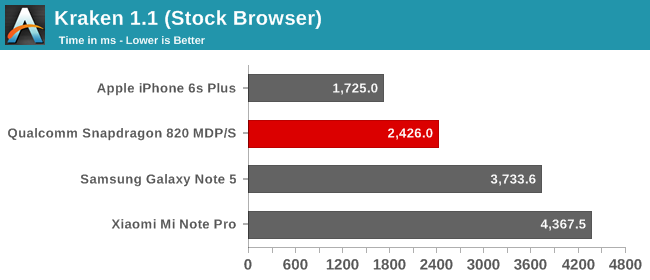
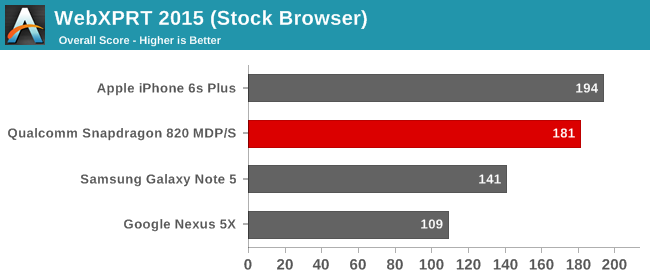
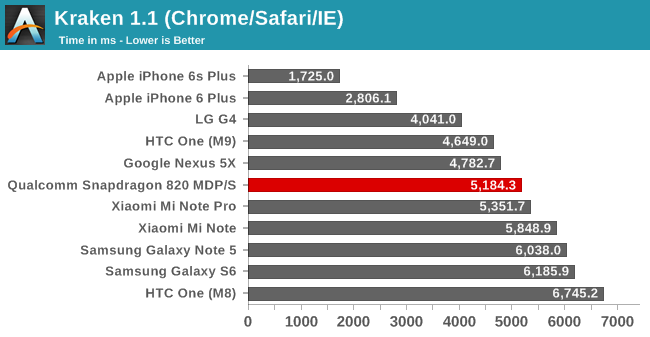

There are two things we can immediately take away from these results. The first is that currently Google Chrome is incredibly unoptimized for Kryo, and this is something Qualcomm was also quick to mention. We won’t wax on about this as there’s nothing to say we haven’t said before, but Chrome could certainly stand to implement optimized JS engines sooner.
Otherwise if we look at Qualcomm’s native browser, things are greatly improved. Relative to both the Exynos 7420 (A57) powered Note 5 and the Snapdragon 810 (A57) powered Mi Note Pro, the MDP/S shows a significant lead. In fact it pretty much blows past those devices in Kraken. However while it easily takes the top spot for an Android device, even with Qualcomm’s native browser the 820 isn’t going to be able to catch up to the iPhone 6s Plus and its A9 SoC.

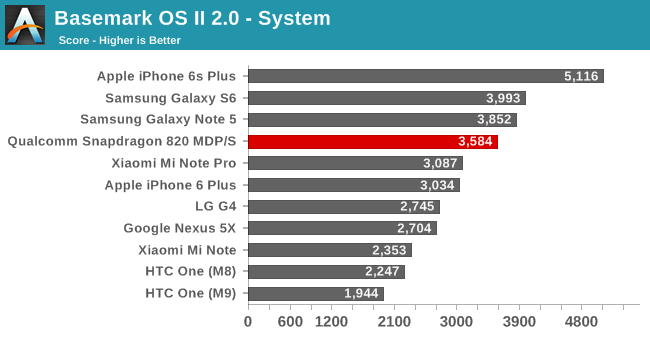
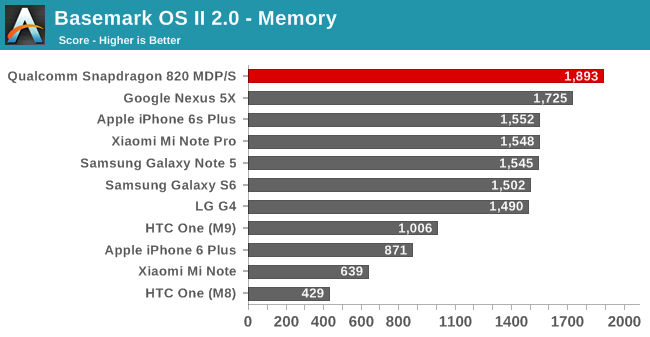
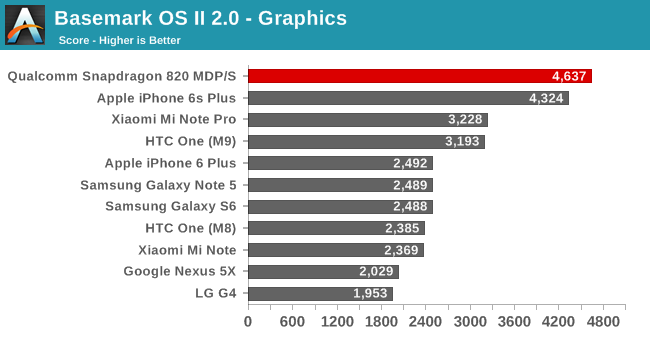
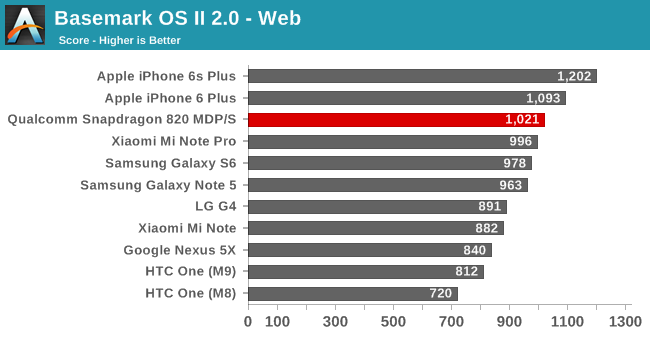
Basemark OS II 2.0 on the other hand is less consistent. The overall score again pegs the MDP/S as the best Android device, and by over 20%. However for reasons yet to be determined, the system score is still below the latest Samsung devices. Instead where the 820 shows a clear lead is with the storage (memory) score and the graphics score. In some cases it’s even beating the iPhone 6s Plus, though overall it will fall short.

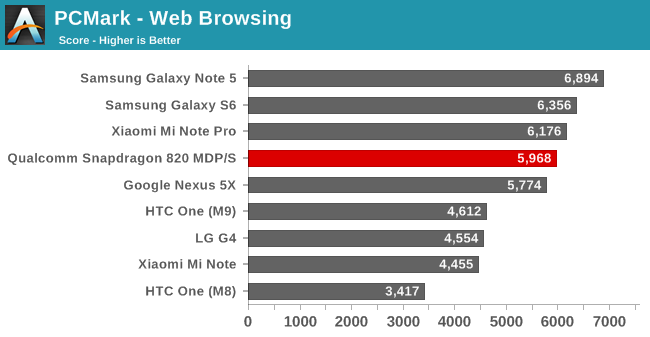
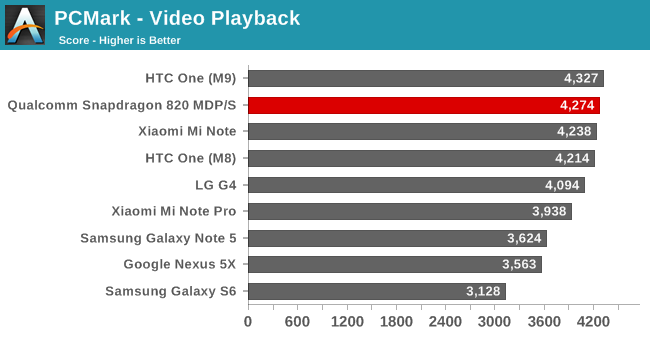
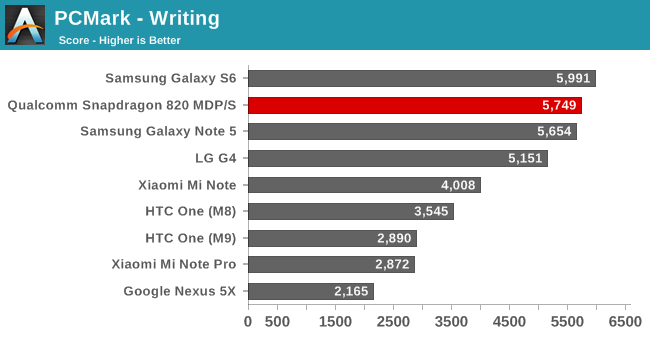
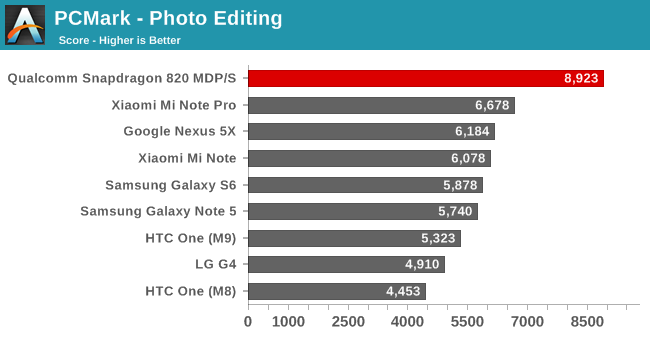
Our final system benchmark, PCMark, once again puts the MDP/S in a good light overall, while the individual sub-tests are more widely varied. Likely owing to the same optimization issues that dogged Chrome performance, web browsing performance trails the A57 devices. Meanwhile video playback closely trails the Snapdragon 810 powered HTC One M9, and writing performance won’t quite surpass the Galaxy S6. Where the 820 MDP/S makes up for it is in the photo editing score, which is through the roof. Here Qualcomm’s development device holds a 34% performance lead over the next-fastest device, the 810/A57 based Mi Note Pro.










146 Comments
View All Comments
Andrei Frumusanu - Thursday, December 10, 2015 - link
> That doesnt just happen automagically ... the app needs to be specifically coded to do that.The app doesn't have to be coded for it. The photo processing part is done in RenderScript by stock Android APIs and that can use the GPU or fall back to the CPU if it fails to do so. Almost all recent Android devices use the GPU. The only time I saw something explicitly fall back to the CPU was on the G4 and it was just a small portion of the test.
jospoortvliet - Saturday, December 12, 2015 - link
This is interesting, perhaps add such information in the article next time?jospoortvliet - Saturday, December 12, 2015 - link
This is interesting, perhaps add such information in the article next time?tuxRoller - Thursday, December 10, 2015 - link
Who cares about die size? Sure, it can affect yield and pricing but it obviously isn't affecting then much and, in the only evaluation that matters, Apple is able to have a CPU that obliterates every other mobile chip AND is and to sustain peak performance.BTW, do you have a link to a kryo device that scores 2.1k on int? All of the ones I've seen are around 1.8k, with their total brought up by their massive memory and fp scores (totals if around 2.5k).
Wilco1 - Saturday, December 12, 2015 - link
820 vs A72 results: http://browser.primatelabs.com/geekbench3/4159755Shadowmaster625 - Thursday, December 10, 2015 - link
I would have liked to have seen a comparison of S810 MDP vs final hardware so we can get some kind of idea of the amount of optimization to expect.Ryan Smith - Thursday, December 10, 2015 - link
S810 MDP/T was a tablet, and S810 suffered badly under 20nm planar. If you want to see how it compares check out our HTC One M9 review, but it wouldn't tell us anything useful about what MDP/S -> retail will look like.cfenton - Thursday, December 10, 2015 - link
This doesn't inspire confidence. 820 looks much better than 810 at ST tasks and worse or equal in MT tasks, which seems like a good trade-off to me. However, seeing the 820 beaten in almost every benchmark by the A9 is troubling. You can't launch a flagship product six months after a competitor that performs worse than that competitor's product. Well, I guess you can, but it doesn't seem like a good move.Even if you rule out the A9, since other manufacturers can't buy those, it's not that much better than Samsung's almost year-old (by the time the 820 is in a product) SoC in the GS6.
tipoo - Thursday, December 10, 2015 - link
I'm curious what will be in the GS7. Another Exynos in the NA market? If they keep the momentum from the last one, they could perhaps punch above the 820 just like they did the 810. Not sure if their custom cores will be ready in time though?
Araa - Thursday, December 10, 2015 - link
To be frank, same thing has been happening since the A7 (even the A6). Problem is back then they used to cheat on Benchmarks or only show us bs Benchmarks like Antutu that only care about the number of cores so the numbers lied back then, they do now too just not as outrageous as before...